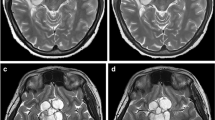Abstract
Background
Motion artifacts pose significant problems for the acquisition of MR images in pediatric populations.
Objective
To evaluate temporal motion metrics in MRI scanners and their effect on image quality in pediatric populations in neuroimaging studies.
Materials and methods
We report results from a large pediatric brain imaging study that shows the effect of motion on MRI quality. We measured motion metrics in 82 pediatric patients, mean age 13.4 years, in a T1-weighted brain MRI scan. As a result of technical difficulties, 5 scans were not included in the subsequent analyses. A radiologist graded the images using a 4-point scale ranging from clinically non-diagnostic because of motion artifacts to no motion artifacts. We used these grades to correlate motion parameters such as maximum motion, mean displacement from a reference point, and motion-free time with image quality.
Results
Our results show that both motion-free time (as a ratio of total scan time) and average displacement from a position at a fixed time (when the center of k-space was acquired) were highly correlated with image quality, whereas maximum displacement was not as good a predictor. Among the 77 patients whose motion was measured successfully, 17 had average displacements of greater than 0.5 mm, and 11 of those (14.3%) resulted in non-diagnostic images. Similarly, 14 patients (18.2%) had less than 90% motion-free time, which also resulted in non-diagnostic images.
Conclusion
We report results from a large pediatric study to show how children and young adults move in the MRI scanner and the effect that this motion has on image quality. The results will help the motion-correction community in better understanding motion patterns in pediatric populations and how these patterns affect MR image quality.




Similar content being viewed by others
References
Cote CJ, Wilson S, Work Group on Sedation (2008) Guidelines for monitoring and management of pediatric patients during and after sedation for diagnostic and therapeutic procedures: an update. Paediatr Anaesth 18:9–10
Becke K, Landsleitner B, Reinhold P et al (2010) Diagnostic and interventional operations in childhood: anesthesiology management. Anaesthesist 59:1013–1020
Krauss B, Green SM (2008) Training and credentialing in procedural sedation and analgesia in children: lessons from the United States model. Paediatr Anaesth 18:30–35
Schulte-Uentrop L, Goepfert MS (2010) Anaesthesia or sedation for MRI in children. Curr Opin Anaesthesiol 23:513–517
Havidich JE, Beach M, Dierdorf SF et al (2016) Preterm versus term children: analysis of sedation/anesthesia adverse events and longitudinal risk. Pediatrics 137:1–9
Aksoy M, Forman C, Straka M et al (2011) Real-time optical motion correction for diffusion tensor imaging. Magn Reson Med 66:366–378
Ooi MB, Aksoy M, Maclaren J et al (2013) Prospective motion correction using inductively coupled wireless RF coils. Magn Reson Med 70:639–647
Thesen S, Heid O, Mueller E et al (2000) Prospective acquisition correction for head motion with image-based tracking for real-time fMRI. Magn Reson Med 44:457–465
Tisdall MD, Hess AT, Reuter M et al (2012) Volumetric navigators for prospective motion correction and selective reacquisition in neuroanatomical MRI. Magn Reson Med 68:389–399
Van der Kouwe AJ, Benner T, Dale AM (2006) Real-time rigid body motion correction and shimming using cloverleaf navigators. Magn Reson Med 56:1019–1032
Pipe JG (1999) Motion correction with PROPELLER MRI: application to head motion and free-breathing cardiac imaging. Magn Reson Med 42:963–969
White N, Roddey C, Shankaranarayanan A et al (2010) PROMO: real-time prospective motion correction in MRI using image-based tracking. Magn Reson Med 63:91–105
Zaitsev M, Dold C, Sakas G et al (2006) Magnetic resonance imaging of freely moving objects: prospective real-time motion correction using an external optical motion tracking system. Neuroimage 31:1038–1050
Power JD, Barnes KA, Snyder AZ et al (2012) Spurious but systematic correlations in functional connectivity MRI networks arise from subject motion. Neuroimage 59:2142–2154
Van Dijk KR, Sabuncu MR, Buckner RL (2012) The influence of head motion on intrinsic functional connectivity MRI. Neuroimage 59:431–438
Yendiki A, Koldewyn K, Kakunoori S et al (2014) Spurious group differences due to head motion in a diffusion MRI study. Neuroimage 88:79–90
Reuter M, Tisdall MD, Qureshi A et al (2015) Head motion during MRI acquisition reduces gray matter volume and thickness estimates. Neuroimage 107:107–115
Gholipour A, Polak M, Van der Kouwe A et al (2011) Motion-robust MRI through real-time motion tracking and retrospective super-resolution volume reconstruction. Conf Proc IEEE Eng Med Biol Soc 2011:5722–5725
Likert R (1932) A technique for the measurement of attitudes. Arch Psych 22:1–55
Maclaren J, Herbst M, Speck O et al (2013) Prospective motion correction in brain imaging: a review. Magn Reson Med 69:621–636
Gholipour A, Afacan O, Aganj I et al (2015) Super-resolution reconstruction in frequency, image, and wavelet domains to reduce through-plane partial voluming in MRI. Med Phys 42:6919–6932
Gholipour A, Estroff J, Warfield SK (2010) Robust super-resolution volume reconstruction from slice acquisitions: application to fetal brain MRI. IEEE Trans Med Imaging 29:1739–1758
Erem B, Afacan O, Gholipour A et al. (2014) A system identification approach to estimating a dynamic model of head motion for MRI motion correction. Intelligent MRI Workshop. MICCAI. http://crl.med.harvard.edu/publications/Year/2014%20Papers/Erem2014IntellMRWorkshopMICCAI.pdf. Accessed 14 June 2016
Yuan W, Altaye M, Ret J et al (2009) Quantification of head motion in children during various fMRI language tasks. Hum Brain Mapp 30:1481–1489
Acknowledgments
This work was funded in part by National Institutes of Health grants 5R42MH086984, 1R01EB019483, 5R01EB018988 and 5R01EB013248.
Author information
Authors and Affiliations
Corresponding author
Ethics declarations
Conflicts of interest
None
Rights and permissions
About this article
Cite this article
Afacan, O., Erem, B., Roby, D.P. et al. Evaluation of motion and its effect on brain magnetic resonance image quality in children. Pediatr Radiol 46, 1728–1735 (2016). https://doi.org/10.1007/s00247-016-3677-9
Received:
Revised:
Accepted:
Published:
Issue Date:
DOI: https://doi.org/10.1007/s00247-016-3677-9




